How to Clean Carpet at Home by Hand (Easy & Effective Methods Anyone Can Use)
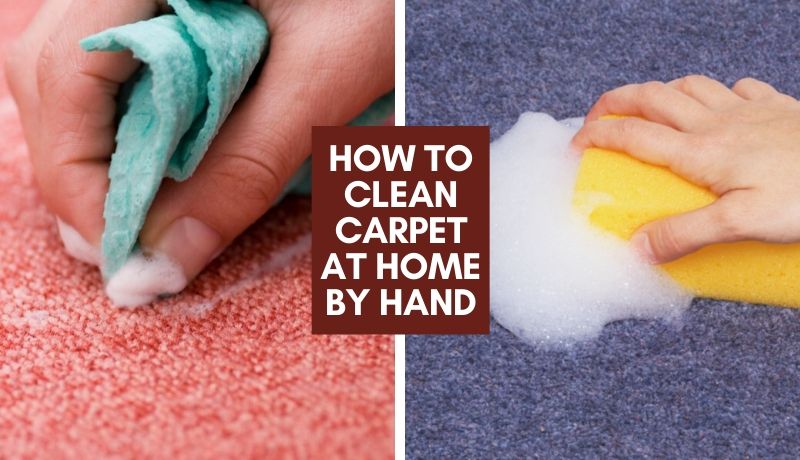
As an Amazon Associate I earn from qualifying purchases.
Cleaning a carpet at home might seem challenging, especially when you’re unsure about what products to use or how often to clean. While hiring someone is an option, it’s not always necessary. You can effectively clean your carpet yourself with the right techniques.
This guide will show you simple, safe methods to clean your carpet using common household ingredients. Follow these tips, and you’ll be able to maintain a clean carpet with ease.
Contents
How to Clean Carpet at Home by Hand (Step-by-Step)
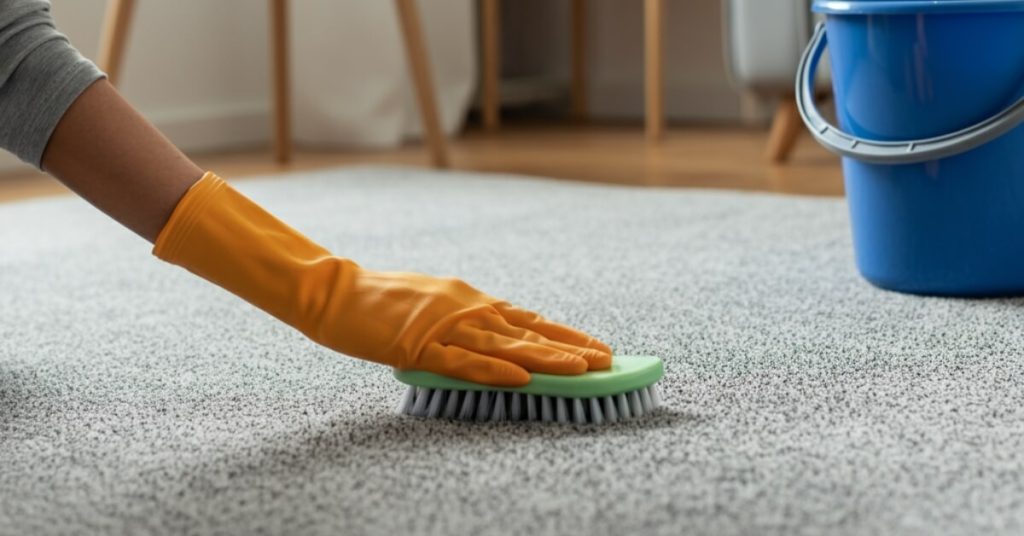
Successfully cleaning carpet by hand requires a systematic approach. Following these steps ensures you don’t inadvertently spread stains or damage your carpet fibers.
Step 1: Vacuum Thoroughly
Remove all loose dirt, pet hair, and debris before applying any cleaning solution. This prevents you from turning dry soil into muddy paste during the cleaning process. Pay extra attention to high-traffic areas and use your vacuum’s crevice tool around baseboards and furniture legs.
Step 2: Choose the Right Cleaning Solution
Select your homemade carpet cleaner based on the type of stain you’re addressing. For general cleaning, a mixture of warm water and gentle dish soap works well. Grease stains respond better to solutions containing white vinegar, while protein-based stains (like blood or food) may require enzyme-based cleaners or hydrogen peroxide mixtures.
Step 3: Test a Small Area
Before applying any solution to the visible stain, test it on an inconspicuous area of carpet. Apply a small amount and wait 10-15 minutes to check for color bleeding or fiber damage. This step is crucial for maintaining your carpet’s appearance and avoiding costly mistakes.
Step 4: Apply and Scrub Gently
Work the cleaning solution into the stain using a soft-bristled brush, clean cloth, or sponge. Always scrub from the outside of the stain toward the center to prevent spreading. Use gentle, circular motions rather than aggressive back-and-forth scrubbing that can damage carpet fibers.
Step 5: Blot Excess Moisture
After scrubbing, use clean, absorbent towels to blot away excess moisture and lifted dirt. Press firmly but avoid rubbing, which can push the stain deeper into the carpet backing. Continue blotting with fresh sections of towel until no more liquid transfers.
Step 6: Allow Proper Drying

Ensure adequate ventilation and allow the carpet to dry completely before walking on it. This typically takes 6-12 hours, depending on humidity and air circulation. Place fans nearby to speed the process and prevent mold or mildew growth in the carpet padding.
8 Best DIY Methods to Clean Carpet by Hand
These homemade carpet cleaner recipes address different types of stains and cleaning situations using common household items.
1. Baking Soda and Vinegar Method
Sprinkle baking soda generously over the stained area and let it sit for 15 minutes to absorb odors and moisture. Mix equal parts white vinegar and warm water in a spray bottle, then spray over the baking soda. The fizzing action helps lift dirt and stains. Scrub gently with a brush, then blot dry.
2. Dish Soap and Warm Water Solution
Mix one tablespoon of clear dish soap with two cups of warm water. This gentle solution works well for most food stains and general cleaning. Apply with a cloth, work into the stain with gentle circular motions, then blot thoroughly with clean water to remove soap residue.
3. Salt and Club Soda Treatment
Perfect for fresh liquid spills, especially red wine or juice. Immediately blot up excess liquid, then pour club soda over the stain and blot again. Sprinkle salt over the area to absorb remaining moisture and prevent staining. Let it sit for 10 minutes before vacuuming up the salt.
4. Hydrogen Peroxide Mix
Combine one part 3% hydrogen peroxide with two parts water for a powerful stain-fighting solution. This works particularly well on blood, sweat, and other protein-based stains. Apply to the stain, let it sit for 30 seconds, then blot thoroughly. Always test first, as hydrogen peroxide can bleach some carpet dyes.
5. Lemon Juice for Tough Stains
The natural acidity in lemon juice helps break down many types of stains. Mix fresh lemon juice with salt to create a paste for older, set-in stains. Apply the paste, let it sit for 10 minutes, then scrub gently with a brush before blotting clean with water.
6. Cornstarch for Oil-Based Stains
Grease and oil stains require special attention. Sprinkle cornstarch liberally over fresh oil stains and let it absorb the oil for at least 15 minutes. Vacuum up the cornstarch, then treat any remaining stain with dish soap and warm water.
7. Steam Treatment with Towels
For deep cleaning without chemicals, dampen a clean towel with hot water and place it over the stained area. Iron over the towel on a low setting, allowing the steam to penetrate the carpet. The heat and moisture help loosen embedded dirt, which you can then blot away.
8. Carpet Shampoo and Brush Method
Mix commercial carpet shampoo according to package directions, or create your own by combining ¼ cup white vinegar, 1 tablespoon dish soap, and 2 cups warm water. Apply with a soft brush, work into a light lather, then rinse thoroughly with clean water.
Why Clean Your Carpet by Hand?
Hand cleaning carpets might seem like extra work, but this approach offers several advantages that make it worth considering for your home maintenance routine.
1. Cost-Effective and Accessible
Professional carpet cleaning services can cost anywhere from $100 to $300 per visit, while machine rentals typically run $30 to $50 per day. Hand cleaning, by contrast, relies on items you likely already have: dish soap, baking soda, vinegar, and basic cleaning tools.
This makes it an ideal solution for budget-conscious households or anyone who needs to clean carpets frequently due to pets, children, or high foot traffic.
2. Perfect for Spot Cleaning and Emergency Situations
Spills happen at inconvenient times. When your toddler drops juice on the living room carpet at 8 PM on a Sunday, you can’t run to the rental store or call a professional service. Hand cleaning techniques let you address stains immediately, which often makes the difference between a minor cleanup and a permanent mark.
3. Gentle on Delicate Materials
Some carpets require careful handling that aggressive machines can’t provide. Wool carpets, antique rugs, and certain synthetic materials benefit from the controlled pressure and targeted attention that manual cleaning offers. You can adjust your technique based on the carpet’s response, something impossible with preset machine settings.
4. Complete Control Over Cleaning Products
Many commercial carpet cleaners contain harsh chemicals that can trigger allergies, leave strong odors, or pose concerns for families with small children and pets. DIY carpet cleaning methods let you choose exactly what touches your flooring, from completely natural solutions to specialized products for specific stain types.
Tips for Different Carpet Types
Different carpet materials require specific approaches to avoid damage during spot cleaning carpet procedures.
Wool Carpets
Wool is naturally stain-resistant but requires gentle treatment. Use cool water instead of hot, which can cause shrinkage. Avoid alkaline cleaners like ammonia, which can damage wool fibers. Stick to pH-neutral solutions and always blot rather than scrub. Professional cleaning is recommended for valuable wool rugs.
Synthetic Carpets (Nylon, Polyester, Olefin)
These durable materials can handle stronger cleaning solutions and more vigorous scrubbing. Most DIY carpet cleaning methods work well on synthetic fibers. They’re also more resistant to bleaching, making hydrogen peroxide treatments safer to use.
Plush and Cut-Pile Carpets
The dense, upright fibers in plush carpets can trap dirt deeply. Use a soft brush to work cleaning solutions down to the carpet backing, but brush in one direction only to maintain the pile’s appearance. Vacuum thoroughly both before and after cleaning.
Berber and Loop-Pile Carpets
The looped construction makes these carpets prone to snagging. Use only blotting motions and avoid scrubbing that might catch and pull loops. Clean spills immediately, as the tight weave can make stain removal more difficult once they set.
Maintaining Your Hand-Cleaned Carpet

Regular maintenance keeps your carpet looking its best between deep cleaning sessions. Vacuum high-traffic areas twice weekly and address spills immediately to prevent staining. Rotate furniture periodically to prevent permanent indentations and even out wear patterns.
For households with pets or children, keep a carpet cleaning kit readily available with your preferred homemade solution, clean towels, and a soft brush. Quick action often means the difference between a minor cleanup and a permanent stain.
Consider applying carpet protector spray after cleaning to make future spills easier to clean. These products create a barrier that prevents liquids from immediately soaking into carpet fibers, giving you more time to address accidents.
Conclusion
Cleaning your carpet at home by hand is not only affordable but also surprisingly effective when done right. Whether you’re dealing with tough stains or just routine dirt, a little time and effort using everyday household items can leave your carpets looking refreshed and well-maintained.
From spot treatments to full-surface cleaning, these methods are perfect for anyone looking to avoid harsh chemicals or expensive equipment. Stay consistent with gentle cleaning habits, and your carpet will stay cleaner, longer, without the hassle.
Frequently Asked Questions
Is it safe to clean all carpets by hand?
Most carpets can be safely hand-cleaned using gentle methods, but always test cleaning solutions in an inconspicuous area first. Antique, silk, or very expensive rugs may require professional cleaning to avoid damage. When in doubt, consult your carpet manufacturer’s care instructions.
How often should I hand-clean my carpet?
Spot clean spills immediately and do thorough hand cleaning of high-traffic areas monthly. For complete carpet cleaning, every 3-6 months is sufficient for most households, though homes with pets or small children may need more frequent attention.
Can I use vinegar on all carpet types?
White vinegar is safe for most synthetic carpets but should be used cautiously on wool and natural fiber rugs. The acidity can damage natural proteins in wool over time. Always dilute vinegar with water and test first on a small area.
How long does it take for hand-cleaned carpet to dry?
Drying time varies based on humidity, air circulation, and how much moisture was used. Typically, carpets dry within 6-12 hours. Improve drying time by using fans, opening windows, or running a dehumidifier. Avoid walking on damp carpet to prevent re-soiling.
What if stains come back after drying?
Recurring stains often indicate that cleaning solution or soap residue remains in the carpet. Rinse the area thoroughly with clean water and blot dry. If the original stain returns, it may have penetrated into the carpet backing and require professional treatment or repeated gentle cleaning attempts.
As an Amazon Associate I earn from qualifying purchases.



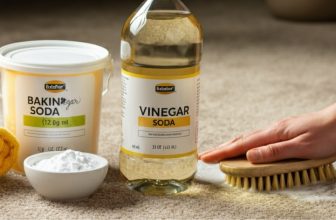
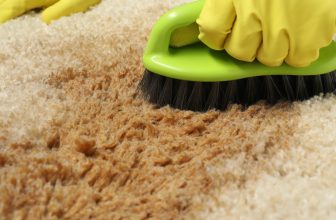

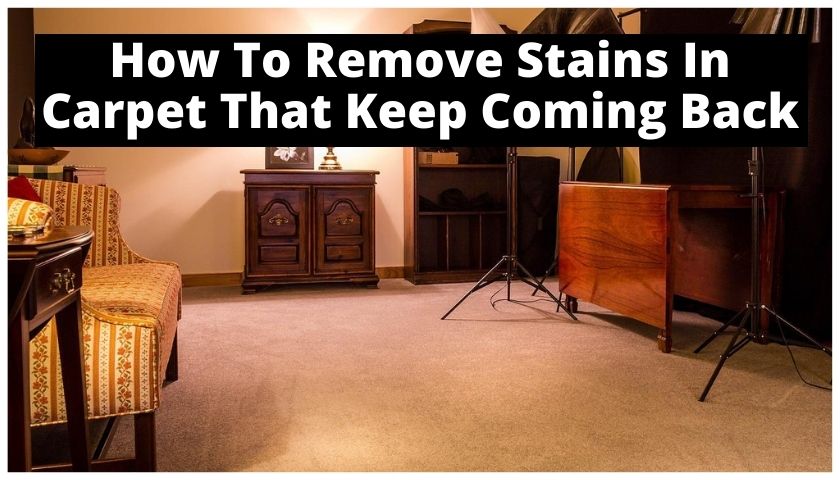


[…] Clean Carpet At Home By Hand […]
[…] more about carpet cleaning in the following articles: How To Clean Carpet At Home By Hand How to get wax out of carpet Get slime out of carpet easily How to get vomit smell out of carpet, […]
[…] Related post: How to clean a carpet at home by hand […]
[…] Don’t miss: How to clean a carpet at home by hand […]
[…] gets dirty frequently, especially if you have pets, kids, or parties at home. On the other hand, carpet cleaning is one of the trickiest jobs among the entire house cleaning work. You can use a magic eraser to […]
[…] Read next: How to clean carpet yourself […]
[…] can easily clean up your carpet at home with natural ingredients from your cupboard. Some easy processes to clean carpet at […]
[…] Deep clean carpets, rugs, and floor mat […]